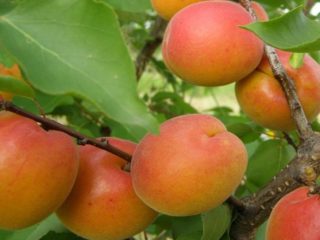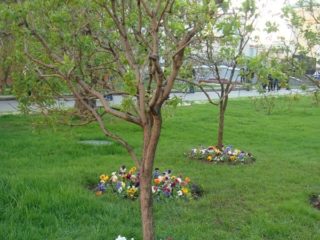Content
The description of the apricot variety Champion of the North implies its use in the Central Black Earth Region. Due to its hardiness and frost resistance, the culture has spread much more widely.
Breeding history
The progenitor of the Champion of the North is considered to be the well-known and widespread apricot Triumph of the North. It was on its basis that a new promising variety was bred by crossing free pollination with other varieties of apricot and subsequent sowing. Breeding work on the development of the Champion of the North was carried out on the basis of the Voronezh State Agrarian University (Voronezh State Agrarian University) under the guidance of two botanists: L.A. Dolmatova and A.N. Venyaminov in the 70s of the last century.
The goal of the breeders was to obtain apricots that survive and successfully bear fruit in the extreme conditions of severe winter frosts, interspersed with sudden sharp thaws. Such a changeable climate in winter, as well as the probable late spring frosts are characteristic of the Central Black Earth zone, for which the apricot variety was intended. Over time, the Champion of the North began to be cultivated far beyond these limits: in Belgorod, Voronezh, Tambov, Kursk, Lipetsk and even in Moscow (Moscow region) regions.

The Northern Triumph was used in the development of many frost-resistant apricot varieties
Description of the variety
Compared to other apricot trees, often reaching 8 m in height, the Champion of the North is considered a small variety, since it rarely outgrows 4-5 m. Due to slowly forming shoots, its spherical crown is not too dense, sparse, but the skeletal branches are powerful and thick, covered with a smooth brownish-brown bark. The leaf blades of the Champion of the North apricot are of regular shape, medium size, shiny and smooth, colored in a standard light green hue, which changes to a spectacular orange-red in autumn.
Delicate flowers are pink-lilac or almost white with juicy pink stamens, rather large (up to 30 mm). Champion of the North is a self-fertile variety, since both female and male flowers are present on the tree at the same time. Thorny shoots on apricot shoots, bearing buds (floral and vegetative), end in beautiful inflorescences.
The ripe fruits of the Champion of the North, judging by the numerous photos of gardeners growing this apricot, are round-oval, covered with a thick velvety-pubescent rind of a rich sunny orange color with a light crumbly raspberry blush. The inner flesh of an apricot is slightly sour, refreshingly sweet, dense and dry, easily separating from a rather large loose stone. The apricot kernel is edible, sweet, with a pronounced almond flavor.
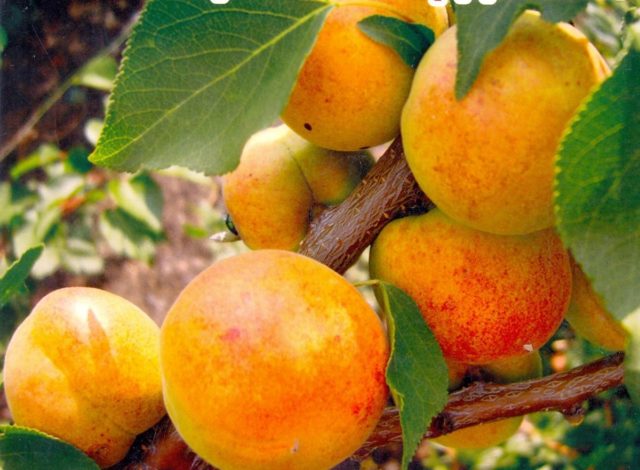
The fruits of this apricot variety are very attractive in appearance.
Characteristics
The Champion of the North received exceptional varietal characteristics from his ancestor. They allow the apricot to survive in places with completely unsuitable climates.
Drought tolerance, winter hardiness
The most important quality that distinguishes the Champion of the North from other varieties of apricots is its amazing winter hardiness. The wood of the trunk and branches is able to withstand frosts with dignity down to -35 ° C and even lower. Flower buds show a slightly worse frost resistance and in especially harsh winters they often freeze slightly (with sharp jumps in temperature). But the Champion of the North variety is endowed with a natural ability to regenerate, therefore it is restored on its own, while freezing practically does not affect the apricot yield.
The Champion of the North survives the heat of many days (above +25 ° C) easily - thanks to its strong and thick bark. The lack of natural precipitation does not in any way affect the formation of the ovary and the ripening of apricots, if the trees are watered regularly and abundantly, as well as mulch the soil in the near-trunk circle.
Pollination, flowering period and ripening times
The flowering period of apricots is short - no more than 10 days, usually in the last week of April or the first half of May. The Champion of the North is self-pollinated, but in order to increase yields, experienced gardeners recommend planting pollinating plants of other related apricot varieties (Lel, Triumph North) in the immediate vicinity. In terms of ripening times, the Champion of the North is attributed to mid-late varieties.
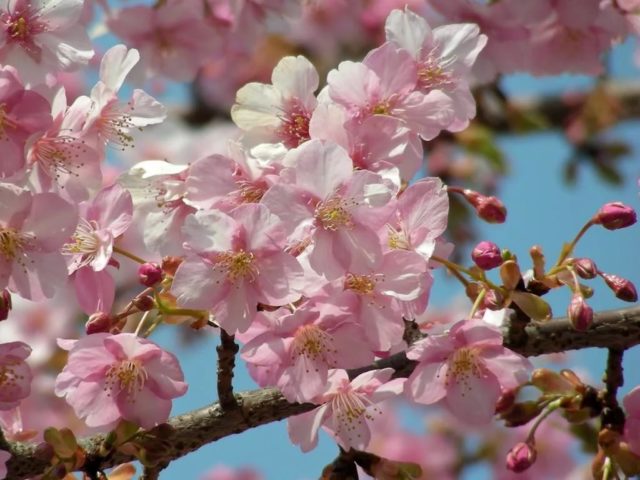
The branches of an apricot tree are covered with flowers
Productivity, fruiting
A young seedling of the Champion of the North blooms for the first time already in the third season after planting; in the same year, insignificant fruiting can be expected. Apricot trees reach their peak yield (25-30 kg) at 5-6 years of age, they can live up to 30-35 years. The maximum weight of one ripe fruit is 65 g, on average, the weight usually varies between 50-55 g. If there are too many ovaries on the Champion of the North tree, then the apricots become noticeably smaller, barely reaching 30-35 g. Fruiting is amicable, lasts about 3 -3.5 weeks. Apricot fruits begin to ripen en masse from mid-July.
Scope of the fruit
The Champion of the North has a universal field of application. Most often, the fruits are eaten immediately fresh or dried. Apricots are suitable as an ingredient for all kinds of fruit desserts (salads, confiture, jam, preserves). They can be frozen, canned (compotes), and also used to prepare sweet dessert alcoholic beverages (liqueurs, wine, liqueurs).
Disease and pest resistance
Apricot Champion of the North is quite resistant to various infectious and fungal pathologies, demonstrates good immunity to them. However, gardeners warn about the extremely low resistance of the variety to perforated spot and gray mold. All kinds of insects very often settle on apricot trees, causing significant harm to them.
Advantages and disadvantages
The undoubted positive qualities inherent in the Champion of the North include:
- drought resistance;
- excellent and stable yield;
- self-pollination;
- large-fruited;
- high marketability of ripe apricots (appearance);
- early maturity (the first harvest of apricots will be for 3-4 seasons);
- excellent traditional apricot taste;
- transportability;
- the highest frost resistance;
- resistance to a number of diseases (due to a loose and non-thickened crown);
- versatility of use;
- good keeping quality of apricots.
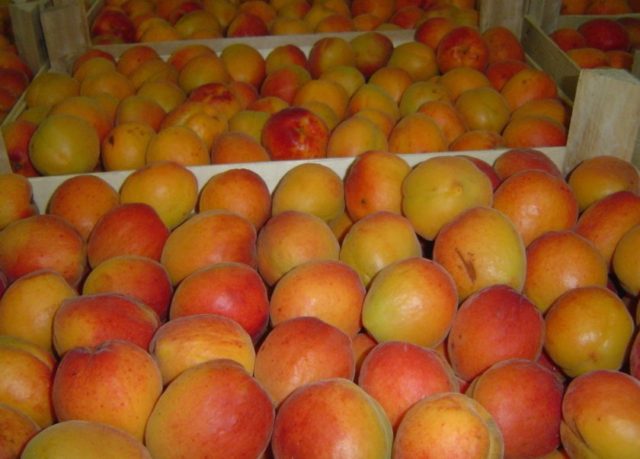
Even proper storage is impossible for a long time.
Along with a lot of advantages, some negative aspects are characteristic of the Champion of the North variety:
- the possibility of freezing (with sharp amplitude changes in temperature) of fruit buds;
- some dryness and fibrousness of ripe apricot fruits, as well as a characteristic sourness (especially of the skin);
- the need for pollinators (in case of unfavorable weather, self-pollination will be poor);
- susceptibility to moniliosis;
- susceptibility to massive attacks by a large number of pests.
Landing features
The Champion of the North is not particularly capricious. However, when planting this apricot, it is necessary to adhere to clear rules of agricultural technology.
Recommended timing
The best time for planting the Champion of the North is considered to be early spring, when nature is just moving away from sleep, and active sap flow has not yet begun. The exact timing directly depends on the local climate. It is permissible to plant apricot trees in the autumn before the onset of stable frosts.
Choosing the right place
When choosing the optimal place for planting apricots, it must be remembered that, like all stone fruits, this culture is very light-requiring. The Champion of the North will develop better and bear fruit more abundantly in well-lit, open and sun-warmed spaces. The occurrence of groundwater close to the surface (above 1.2 m) must not be allowed. Lowlands and flooded areas are not suitable for apricot. The place must be protected from harsh gusty winds and drafts.
What crops can and cannot be planted next to an apricot
Champion of the North, like other varieties of apricots, must be planted separately. He cannot stand close proximity to fruit crops. The large plant competes with shrubs and other trees for moisture and nutrients. Some stone fruits (peach, cherry) have common pests and are susceptible to the same diseases.
The apricot tree is able to get along well in the immediate vicinity only of its direct relatives, who are also pollinators. In the near-stem circle of the age apricot, it is permissible to grow garden and ornamental crops (greenery, flowers, lawn grass).
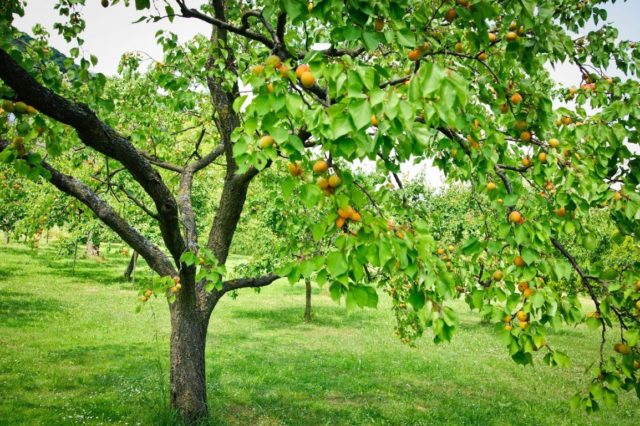
Apricot trees are considered solitary plants.
Selection and preparation of planting material
Best of all, 1-2-year-old seedlings of the Champion of the North take root. Older specimens tolerate transplanting much more difficult. High-quality planting material of apricot is characterized by:
- a healthy and branched root system, without traces of rot and any damage;
- the presence of healthy, large and strong kidneys;
- straight, non-curved barrel;
- several whole and strong branches.
It is better to buy apricot seedlings in the autumn, when the choice is wider and the quality of the planting material is much higher. In order for the apricot tree to survive safely until spring, its roots are dipped in a clay mash, diluted to the consistency of liquid sour cream. After the clay dries a little, the plant is placed in a box with wet sand or sawdust, kept at temperatures up to + 3 + 5 ° C (underground, basement). You can save the Champion of the North apricot in the open field on the site by digging a hole and placing a seedling in it at an angle. Sprinkle the roots with soil.
Landing algorithm
The landing technology of the Champion of the North is as follows:
- In about 3-4 weeks (it is possible even in the fall), a planting pit for an apricot is prepared - with a depth and diameter of about 0.6 m.
- From the excavated fertile soil, humus, low-lying peat and coarse sand, taken in equal parts, adding superphosphate (200-250 g), nitroammophoska (150-170 g) and wood ash (0.8-1 kg), knead the soil mixture.
- A mound is formed from the prepared nutrient soil at the bottom of the pit.
- A support stake is driven in about 10-15 cm from the center.
- Carefully spreading the roots of the apricot in different directions, a seedling of the Champion of the North is placed on the hill and tied to a support. The plant needs to be shortened to 0.6-0.8 m and all branches should be trimmed.
- The planting hole is filled to the top with soil mixture, tamped, trampled down and a roller for irrigation is formed in the near-trunk circle. Lay mulch (needles, peat, humus).
- The apricot seedling is spilled abundantly.
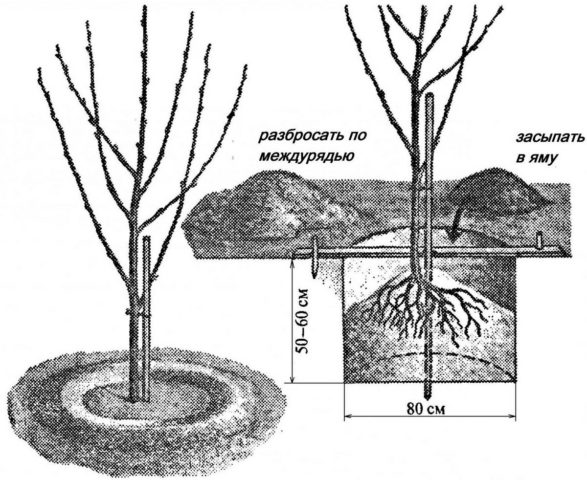
Plant apricot seedlings in the same way as other stone fruit crops
Follow-up care of the culture
Post-plant care of young apricot Champion of the North consists of the following agrotechnical manipulations:
- Rare (3-4 times per season), but abundant (30-50 liters per tree) watering.
- Weeding and loosening apricots (after every good rain and watering).
- Top dressing. After planting (2-3 years), if the hole was filled correctly, the tree does not need to be fertilized additionally. In the future, the specimens of the Champion of the North that have begun to bear fruit are fed at least three times a season: in the spring - nitrogen-containing fertilizers (chicken droppings, slurry), in the summer - superphosphate and potassium salt, in the fall - humus (compost).
- Pruning and crown formation (usually only in the first 3 years).
- Whitewashing of apricot trunks and skeletal branches with protective compounds before winter.
Diseases and pests
The Champion of the North variety shows low resistance to some fungal pathologies:
- Gray rot, otherwise called moniliosis. A dangerous, difficult to treat disease. Spores of the fungus are easily carried by gusts of wind and insects. The disease manifests itself as light gray fluffy growths on all parts of the plant. The affected leaves fold and fall off, the branches dry out. The fruits of the apricot Champion of the North do not reach maturity, cracking still green. As a prophylaxis, spraying with fungicidal agents (Bordeaux mixture, Gamair, Horus) is effective.
- Hole spotting, scientifically klyasternosporiosis. First, gray spots surrounded by a brownish dark rim appear on the leaf blades. Over time, the affected areas dry out, leaving holes through them. Then the foliage dries out completely. The apricots are covered with reddish-brownish markings. Repeated fungicide treatments (copper sulfate, Tsineb, Quadris) will help.
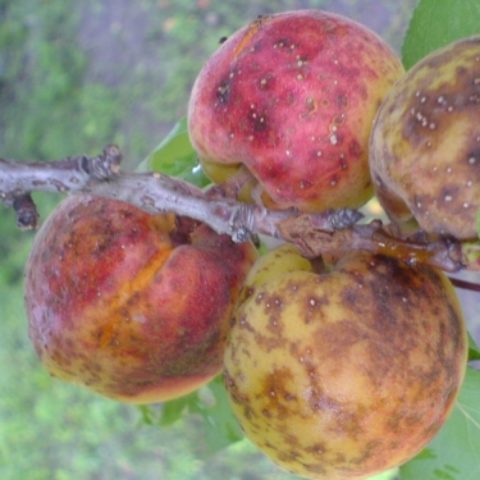
Moniliosis most often affects apricot trees
Apricot trees Champion of the North are periodically exposed to the invasion of harmful insects:
- Weevil... Harmful beetles feed on apricot leaves, not disdaining flowers and fruits (gnaw through passages). The pests are collected by hand and the affected trees are treated with insecticidal preparations (Kinmiks, Inta-Vir).
- Aphid... Young shoots and apricot leaves curl. Numerous small insects sitting inside the cocoon suck out plant juices. The sucking pest will not resist systemic insecticides (Decis, Biotlin).
- Leaf roll... A small moth making a shelter from the dangers of the Champion of the North. She rolls apricot leaf blades into a tube, at the same time feeding on them. The highly effective drug Chlorophos will help.
- Moth... Small whitish-gray butterflies lay their eggs in flowers, on leaf stalks and ovary. Apricots do not grow, rot, crumble. Various traps and belts are used to fight, as well as sparing insecticides (Entobacterin, Rovikurt).
To avoid contamination of apricot trees of the Champion of the North variety with diseases and to minimize the consequences of pest attacks, it is necessary to carry out regular and mandatory preventive treatments. During the period of formation of the ovary and harvest of apricots, it is better to refuse strong chemicals.
Conclusion
A detailed description of the apricot variety Champion of the North promises its increased winter hardiness and unpretentious care. Many gardeners who worked with him confirm the reliability of this information.

